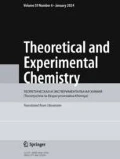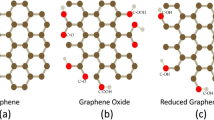A comparative study of electrochemical properties of mono- and few-layer samples of nitrogen-doped graphene as nanosized sensor materials for the qualitative and quantitative determination of dopamine and uric acid has been performed. It is found that the few-layer graphene (NGr(f)) is characterized by high sensibility to dopamine, while monolayer one (NGr(m)) is characterized by high sensibility to uric acid in presence of considerable concentrations of ascorbic acid. XPS results show that the nitrogen content is 8.3 at.% in NGr(f) and 6.2 at.% in NGr(m). The analysis of Raman spectra allows to establish, that NGr(f) and NGr(m) have a defective structure. NGr(f) is characterized mainly by edge defects, while NGr(m) is characterized by vacancies, what obviously predetermines the differences in electrochemical properties of these materials.




Similar content being viewed by others
References
J. Wanga, X. Mub, M. Sun, and T. Mu, Appl. Mater. Today, 16, 1-20 (2019).
R. Kumar, S. Sahoo, E. Joanni, et al., Mater. Today, 39, 47-65 (2020).
F. Catania, E. Marras, M. Giorcelli, et al., Appl. Sci., 21, No. 2, 614 (2021).
S. Ullah, Q. Shi, J. Zhou, et al., Adv. Mater. Interfaces, 7, No. 24, 2000999 (2020).
A. G. Olabi, M. A. Abdelkareem, T. Wilberforce, and E. T. Sayed, Renew. Sustain. Energy Rev., 135, 110026 (2021).
A. T. Lawal, Biosens. Bioelectron., 141, 111384 (2019).
X. Sun, C. Huang, L. Wang, et al., Adv. Mater., 33, No. 6, 2001105 (2021).
Z. Chen, X. An, L. Dai, and Y. Xu, Nano Energy, 73, 104762 (2020).
W. Yu, L. Sisi, Y. Haiyan, and L. Jie, RSC Adv., 10, No. 26, 15328-15345 (2020).
R. Khan, R. Nakagawa, B. Campeon, and Y. Nishina, ACS Appl. Mater. Interfaces, 12, No. 11, 12736-12742 (2020).
O. Yu. Posudievsky, A. S. Kondratyuk, O. A. Kozarenko, et al., Electrochim. Acta., 399, 139410 (2021).
O. Yu. Posudievsky, A. S. Kondratyuk, O. A. Kozarenko, et al., Carbon, 152, 274-283 (2019).
O. Yu. Posudievsky, O. A. Kozarenko, A. S. Kondratyuk, et al., Appl. Surf. Sci., 580, 152279 (2022).
L. Clara, G. D. Giovanni, and S. Galati, J. Neurosci. Methods, 310, 75-88 (2018).
N. Smirnoff, Free Radic. Biol. Med., 122, 116-129 (2018).
N. Charoenngam, B. Ponvilawan, and P. Ungpraser, Mod. Rheumatol., 30, No. 2, 385-390 (2020).
B. J. Matsoso, B. K. Mutuma, C. Billing, et al., Electrochim. Acta., 286, 29-38 (2018).
F. Foroughi, M. Rahsepar, and H. Kim, J. Electroanal. Chem., 827, 34-41 (2018).
S. P. Sasikala, K. Huang, B. Giroire, et al., ACS Appl. Mater. Interfaces, 8, 30964-30971 (2016).
C. He, Z. Li, M. Cai, et al., J. Mater. Chem. A., 1, 1401-1406 (2013).
K. Artyushkova, J. Vac. Sci. Technol. A., 38, No. 3, 031002 (2020).
G. T. Qin, L. Ding, M. Zeng, et al., J. Electroanal. Chem., 866, 114176 (2020).
Y. Bian, H. Wang, J. Hu, et al., Carbon, 162, 66-73 (2020).
A. Kaniyoor and S. Ramaprabhu, AIP Advances, 2, 032183 (2012).
C. Cong and T. Yu, Phys. Rev. B., 89, 235430 (2014).
Y. Celik, E. Flahaut, and E. Suvaci, FlatChem., 1, 74-88 (2017).
A. Eckmann, A. Felten, A. Mishchenko, et al., Nano Lett., 12, No. 8, 3925-3930 (2012).
A. C. R. Fernandez and N. J. Castellani, Surf. Sci., 693, 121546 (2020).
S. Yadav, Z. Zhu, and C. V. Singh, Int. J. Hydrog. Energy, 39, No. 10, 4981-4995 (2014).
C. Zhai, B. Hou, P. Peng, et al., J. Mol. Liq., 249, 9-15 (2018).
B. Li, X. Ying, S. Su, and D. Su, Phys. Chem. Chem. Phys., 17, 6691-6694 (2015).
Author information
Authors and Affiliations
Corresponding author
Additional information
Translated from Teoretychna ta Eksperymentalna Khimiya, Vol. 58, No. 2, pp. 96-103, March-April, 2022.
Rights and permissions
Springer Nature or its licensor holds exclusive rights to this article under a publishing agreement with the author(s) or other rightsholder(s); author self-archiving of the accepted manuscript version of this article is solely governed by the terms of such publishing agreement and applicable law.
About this article
Cite this article
Kozarenko, O.A., Kondratyuk, A.S., Dyadyun, V.S. et al. Mono- and Few-Layer Nitrogen-Containing Graphenes as Sensitive Layers of Electrochemical Sensors for Selective Determination of Dopamine and Uric Acid in the Presence of Ascorbic Acid. Theor Exp Chem 58, 109–117 (2022). https://doi.org/10.1007/s11237-022-09728-3
Received:
Accepted:
Published:
Issue Date:
DOI: https://doi.org/10.1007/s11237-022-09728-3




